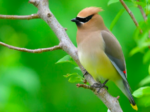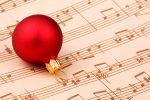Every Friday we invite you and your homeschool students to learn about a different group of North American birds in your recommended bird guide. It’s a great way to add a few minutes of science, geography, natural history, and imagination to your homeschool schedule throughout the year.
This week’s birds (four different families) are the Indigobirds and Whydahs (pages 426–427), the Weavers (pages 426–427), the Estrildid Finches (pages 428–429), and the Old World Sparrows (pages 428–429). That may sound like a lot, but in fact none of these families are native to North America: all are represented by introduced or escaped species only, and just one species from these four groups has spread widely and become naturalized across the continent.
If you’re teaching younger children, the way to use these posts is just to treat your bird guide as a picture book and spend a few minutes each week looking at all the interesting birds they may see one day. With that, your little lesson is done.
If you have older students, one of your objectives should be to help them become fluent with a specialized reference book that’s packed with information, the kind of book they will encounter in many different fields of study. Here’s how your bird guide introduces this week’s birds:
INDIGOBIRDS · WHYDAHS — Family Viduidae. Native to Africa, these species (two genera) are all obligate brood parasites. Pin-tailed Whydah not accepted by ABA. [That is, the American Birding Association doesn’t consider this species sufficiently established to “count” as a North American bird.] Species: 20 World, 1 N.A.
WEAVERS — Family Ploceidae. Large, primarily African family. Breeding males are often highly colored. Build elaborate woven nests. Northern Red Bishop not accepted by ABA. Species: 108 World, 1 N.A.
ESTRILDID FINCHES — Family Estrildidae. Large Old World family found from Africa to Australia and South Pacific Islands. Most are small with pointed tails. Related to weavers. Species: 140 World, 1 N.A.
OLD WORLD SPARROWS — Family Passeridae. Old World family. Gregarious; two species have become established in N.A. Species: 39 World, 2 N.A.
When you’re training your young naturalists, teach them to ask and answer from their bird guide some of the first questions any naturalist would ask about a new group — about the Old World Sparrows, for example. How many species? (39 worldwide.) Are there any near us? (Only two species in North America, both of them introduced from Europe; the individual maps will give us more detail.) What are their distinctive features? (Old World group [i.e., native to Europe, Africa, and Asia, not North or South America], gregarious, and so on.) (And “gregarious” is certainly a wonderful word — be sure to send someone to your homeschool dictionary to look that one up.) 🔎
Pick a representative species or two to look at in detail each week and read the entry aloud, or have your students study it and then narrate it back to you, explaining all the information it contains. This week, for the Old World Sparrow family, why not investigate the familiar House Sparrow (page 428), one of the most common birds in North America and a species every homeschool naturalist should know. (I can hear half a dozen chattering outside my window as I’m typing this.)
All sorts of biological information is packed into the brief species descriptions in your bird guide — can your students tease it out? How big is the House Sparrow? (6¼ inches long.) What is its scientific name? (Passer domesticus.) Will you be able to find this species where you live? At what times of year and in what habitat? (Study the range map and range description carefully to answer those questions, and see the book’s back flap for a map key.) Do the males and females look alike? The adults and juveniles? What song or call does this species make? How can you distinguish it from similar species? (The text and illustrations should answer all these questions.)
House Sparrows are common across North America, mainly in habitats that humans also frequent. (About the only place you never find them is in forests.) They will just as happily nest in the eaves of an urban apartment building as in a rural horse barn. If you had explored the United States at the time of the Civil War or earlier, however, you wouldn’t have found a single one: they were introduced in the late 1800s from Europe and by the mid twentieth century they had spread from coast to coast.
House Sparrows exhibit clear sexual dimorphism: in the breeding season the males sport a black throat and breast, gray cap, and chestnut markings on the head, while the females are rather plain and beige, darker above than below. (The two photos above represent a breeding-plumage male and female.) In the non-breeding season the sexes are still readily distinguishable, although the males are not quite as boldly patterned as they are in spring and summer and look a bit more like the females.
As a second species this week, for fun, why not look at the Pin-tailed Whydah (page 426) in the Indigobird and Whydah family. You’re not likely to see one unless you live near Los Angeles, where they have escaped from captivity and become naturalized in the wild — they are native to Africa and not really a North American species. But that could have been said a century ago about the House Sparrow and they now cover the continent, so who knows what the future may hold.
As your bird guide notes, all members of the Whydah family are brood parasites. They build no nests of their own, and the females spend the breeding season skulking about and locating other birds’ nests, and then dropping their own eggs into them when no one is looking. The Brown-headed Cowbird (page 538) is the only native North American bird that is also a brood parasite.
You can do little ten-minute lessons of this kind with any of the species in your bird guide that catch your interest. Pick one that lives near you, or that looks striking, or that has a strange name, and explore.
In all these Friday Bird Families lessons, our aim is not to present a specific set of facts to memorize. We hope instead to provide examples and starting points that you and your students can branch away from in many different directions. We also hope to show how you can help your students develop the kind of careful skills in reading, observation, and interpretation that they will need in all their future academic work.
What ornithological observations and naturalistical notes did you and your students make in your homeschool this Leo Term? 😊
❡ Homeschool birds: We think bird study is one of the best subjects you can take up in a homeschool environment. It’s suitable for all ages, it can be solitary or social, it can be as elementary or as advanced as you wish, and birds can be found just about anywhere at any season of the year. Why not track your own homeschool bird observations using the free eBird website sponsored by Cornell University. It’s a great way to learn more about what’s in your local area and about how bird populations change from season to season. 🦅
❡ Feed the birds: Setting up a bird feeder is one of the easiest educational activities you can do in a homeschool environment. Here are some tips that will help you get started today! 🐦
❡ Enchiridion: The front matter in your bird guide (pages 6–13) explains a little bit about basic bird biology and about some of the technical terminology used throughout the book — why not have your students study it as a special project. Have them note particularly the diagrams showing the parts of a bird (pages 10–11) so they’ll be able to tell primaries from secondaries and flanks from lores. 🦉
❡ Words for birds: You may not think of your homeschool dictionary as a nature reference, but a comprehensive dictionary will define and explain many of the standard scientific terms you will encounter in biology and natural history, although it will not generally contain the proper names of species or other taxonomic groups that aren’t part of ordinary English. (In other words, you'll find “flamingo” but not Phoenicopterus, the flamingo genus.) One of the most important things students should be taught to look for in the dictionary is the information on word origins: knowing the roots of scientific terms makes it much easier to understand them and remember their meaning. 📖
❡ Come, here's the map: Natural history and geography are deeply interconnected. One of the first questions you should teach your students to ask about any kind of animal or plant is, “What is its range? Where (in the world) does it occur?” Our recommended homeschool reference library includes an excellent world atlas that will help your students appreciate many aspects of biogeography, the science of the geographical distribution of living things. 🌎
❡ Nature notes: This is one of our regular Friday Bird Families posts for homeschool naturalists. Print your own copy of our River Houses Calendar of American Birds and follow along with us! You can also add your name to our free weekly mailing list to get great homeschool teaching ideas delivered right to your mailbox all through the year. 🐦 🦉 🦆 🦃 🦅
❡ Homeschool calendars: We have a whole collection of free, printable, educational homeschool calendars and planners available on our main River Houses calendar page. They will help you create a light and easy structure for your homeschool year. Give them a try today! 🗓
❡ Support our work: If you enjoy our educational materials, please support us by starting your regular Amazon shopping from our very own homeschool teaching supplies page. When you click through from our page, any purchase you make earns us a small commission at no extra cost to you. Thank you for helping us to keep going and growing! 🛒
❡ Join us! The aim of the River Houses project is to create a network of friendly local homeschool support groups — local chapters that we call “Houses.” Our first at-large chapter, Headwaters House, is now forming and is open to homeschoolers everywhere. Find out how to become one of our founding members on the Headwaters House membership page. 🏡




